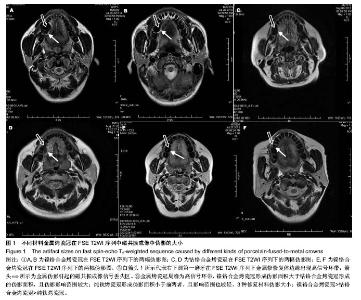| [1] 刘洪臣.口腔修复的发展趋势[J].口腔颌面修复学杂志, 2002, 3(1): 1-2.
[2] 赵铱民.口腔修复学[M].北京:人民卫生出版社,2008:66-67.
[3] 谢南柱,曾仁端.现代医学成像一物理原理与临床应用[M].广州:广东科技出版社,1985:23.
[4] 邵晨樱.俞立英.口腔内金属修复物与磁共振伪影的关系[J].国际口腔医学杂志,2007, 34(2):143-145.
[5] 魏斌,张富强,余强,等.磁性固位体引起MRI伪影的研究[J].口腔颌面修复学杂志,2000,1(4):200-202.
[6] 张伟,王爱军.磁共振检查中口腔金属物对图像的影响及应对策略[J].宁夏医科大学学报,2011,33(2):158-159.
[7] Shafiei F,Honda E,Takahashi H,et al.Artifacts from dental casting alloys in magnetic resonance imaging.J Dent Res. 2003;82(8):602-606.
[8] Harris TM,Faridrad MR,Dickson JA.The benefits of aesthetic orthodontic brackets inpatients requiting multiple MRI scanning. Orthdontics.2006;33(2):90-93.
[9] 高岚,廉云敏,怀海丽.镍铬合金和钴铬合金铸造冠造成MRI图像伪影的比较研究[J].河北医药,2009,31(12):1414-1416.
[10] 刘怀军,赵磊.MRI临床应用基础学[M].石家庄:河北科学技术出版社,2007:514-516.
[11] Costa ALF,Aeenzeller S,Yasuda CL,et al.Artifacts in brain magnetic resonance imaging due to metallic dental objects.Med Oral Patol Oral Vir Bucal.2009;14(6):278-282.
[12] 周芝.镍铬合金与钴铬合金烤瓷修复体对磁共振成像的影响[D].浙江:浙江大学,2011:1-34.
[13] 邵晨婴.口腔内金属修复体与磁共振伪影关系的实验研究[D].上海:复旦大学,2008:1-53.
[14] Guermazi A,Miaux Y,Zaim S,et al.Metallic artifacts in MR imaging:Effects of main field orientation and strength.Clin Radiol.2003;58(4):322-328.
[15] 刘娟.MRI检查中不同口腔金属材料伪影及伪影控制的实验研究[D].天津:天津医科大学,2009:1-51.
[16] 杨正汉,冯逢,王霄英.磁共振成像技术指南[M].北京:人民军医出版社,2007:460.
[17] Blankenstein FH,Truong B,Thomas A,et al.Signal loss in magnetic resonance imaging caused by intraoral anchored dental magnetic materials. Rofo.2006;178(8):787- 793.
[18] 郝楠,潘小波,韩武,等.MRI检查中不同口腔金属材料伪影面积的研究[J].中国临床新医学,2013,6(1):8-11.
[19] 张文禹,王燕一.钯银合金对磁共振成像影响的初步研究[J].中国医学影像学杂志,2010,18(2):171-174.
[20] 刘广顺,王瑶,任庆云,等.金属固定假牙对磁共振成像的影响[J].河北医药,2010,32(3): 262-263.
[21] 包博,施生根,崔三哲,等.金合金、镍络合金铸造冠对磁共振成像检查的影响[J].牙体牙髓牙周病学杂志,2003,13(9):506-508.
[22] Abbaszadeh K,Heffez LB,Mafee MF,et al. Effect of interference of metallic objects on interpretation of T1- Wighted magnetic resonance images in the maxillofacial region.Oral Surg Oral Med Oral Pathol Oral Radiol En dod. 2000;89(6):759-765.
[23] 关小菊,刘娟,李长福.口腔不同材料烤瓷冠磁共振成像伪影的实验研究[J].中华老年口腔医学杂志,2010,8(2):107-109.
[24] Fache JS,Price C,Hawbolt EB,et al.MR imaging artifacts produced by dental materials.AJNR Am J Neuroradiol. 1987; 8(5):837-840.
[25] Eggers G,Rieker M,Kress B,et al.Artifacts in magnetic resonance imaging caused by dental material.Magma. 2005; 18(2):103-111.
[26] 刘玉华,孙樱琳.固定义齿修复材料对MRI图像的影响[J].现代口腔医学杂志,2005, 19(6):588-589.
[27] 应艳.两种金属烤瓷冠引起MRI伪影的研究[J].口腔材料器械, 2010, 19(2):72-74.
[28] 邓承健,何卫红,范锟,等.金属假牙对头部磁共振成像的影响及其处理方法[J].中国医药导报,2012,9(22):104-105.
[29] 于华,张晓东,王亦菁,等.口腔金属材料与影像学伪影的检测与比较[J].中国组织工程研究,2012,16(43):8144-8151.
[30] 王威,姜波,吴宣,等.三种烤瓷合金材料对磁共振成像的影响[J].中国医学科学院学报,2010,32(3):276-279.
[31] 冯全胜,李天侠,李欣,等.三种金属修复体磁共振成像伪影范围的研究[J].中国美容医学,2013,22(2):296-298.
[32] 张文禹,王燕一.口腔金属固定修复体与磁共振图像伪影的关系[J].中华老年口腔医学杂志,2009,7(2):114-117.
[33] Starcuková J,Starcuk Z Jr,Hubálková H,et al.Magnetic susceptibility and electrical conductivity of metallic dental materials and their impact on MR imaging artifacts.Dent Mater. 2008;24(6):715-723.
[34] Jin LY,Lin J.Influence of dental metallic materials on MR imaging.Zhejiang Da Xue Xue Bao Yi Xue Ban. 2009;38(3): 328-332.
[35] Beuf O,Lissac M,Crémillieux Y,et al.Correlation between magnetic resonance imaging disturbances and the magnetic susceptibility of dental materials.Dent Mater.1994;10(4): 265-268.
[36] Behr M,Fellner C,Bayreuther G,et al.MR-imaging of the TMJ: artefacts caused by dental alloys.Eur J Prosthodont Restor Dent.1996;4(3):111-115. |

